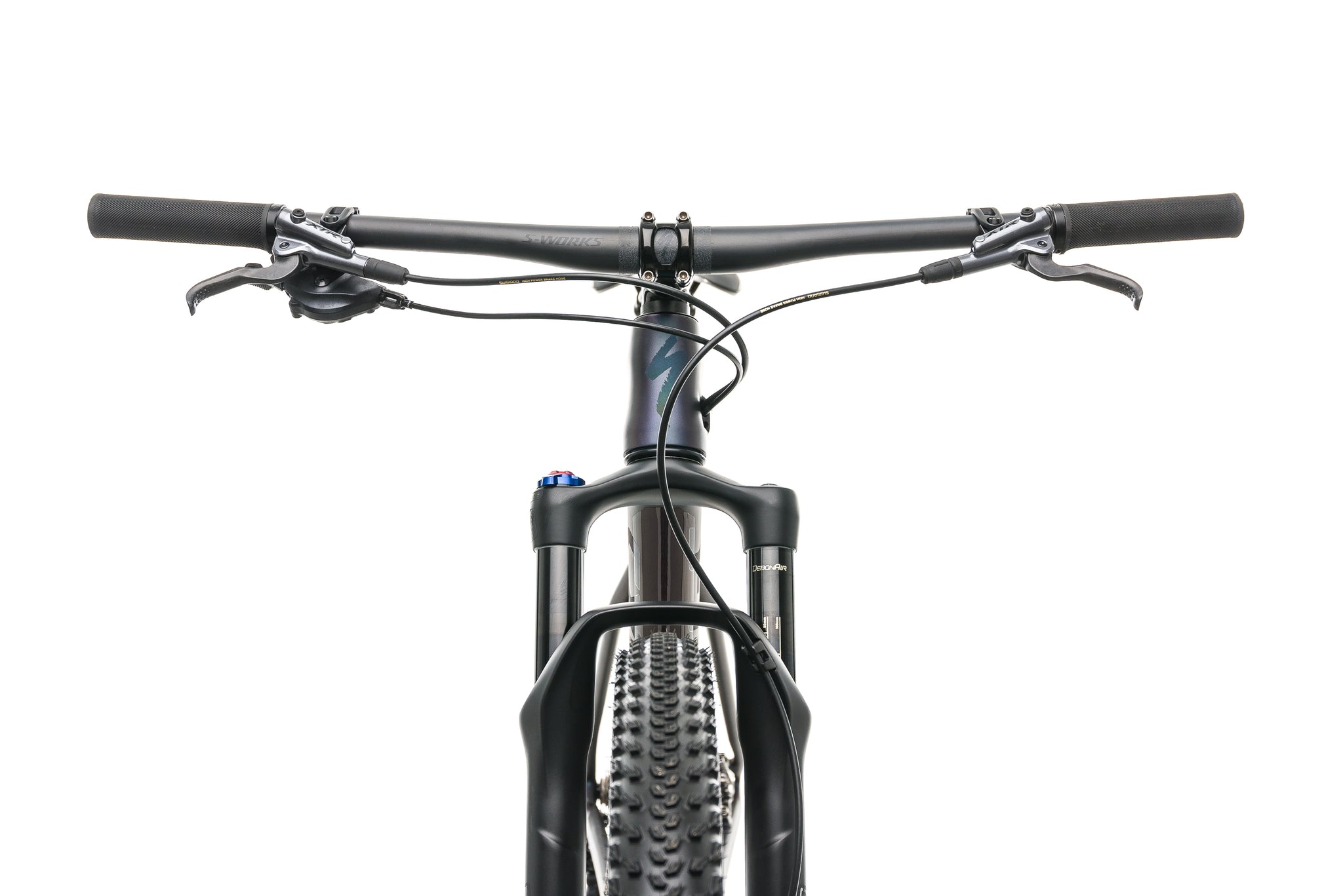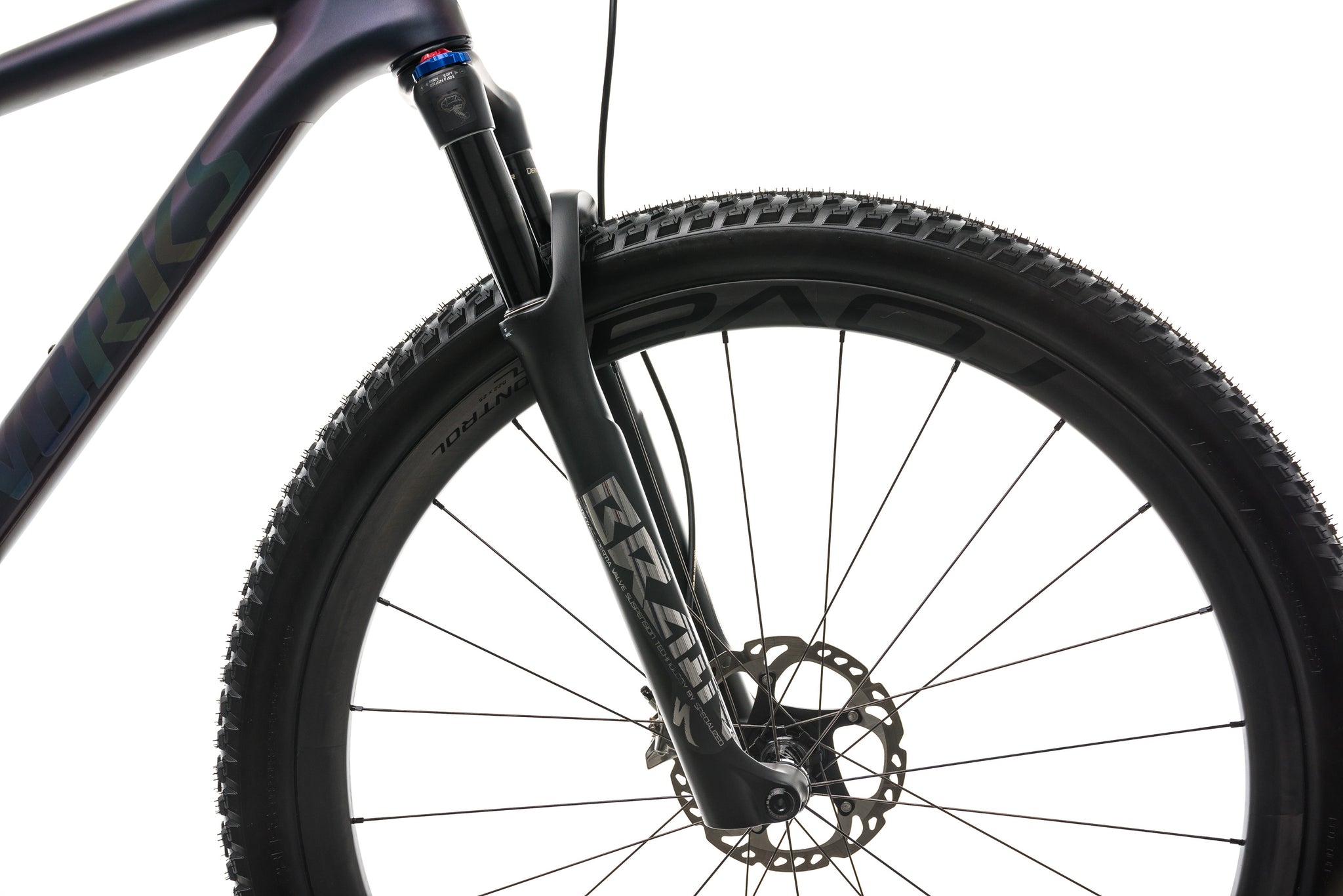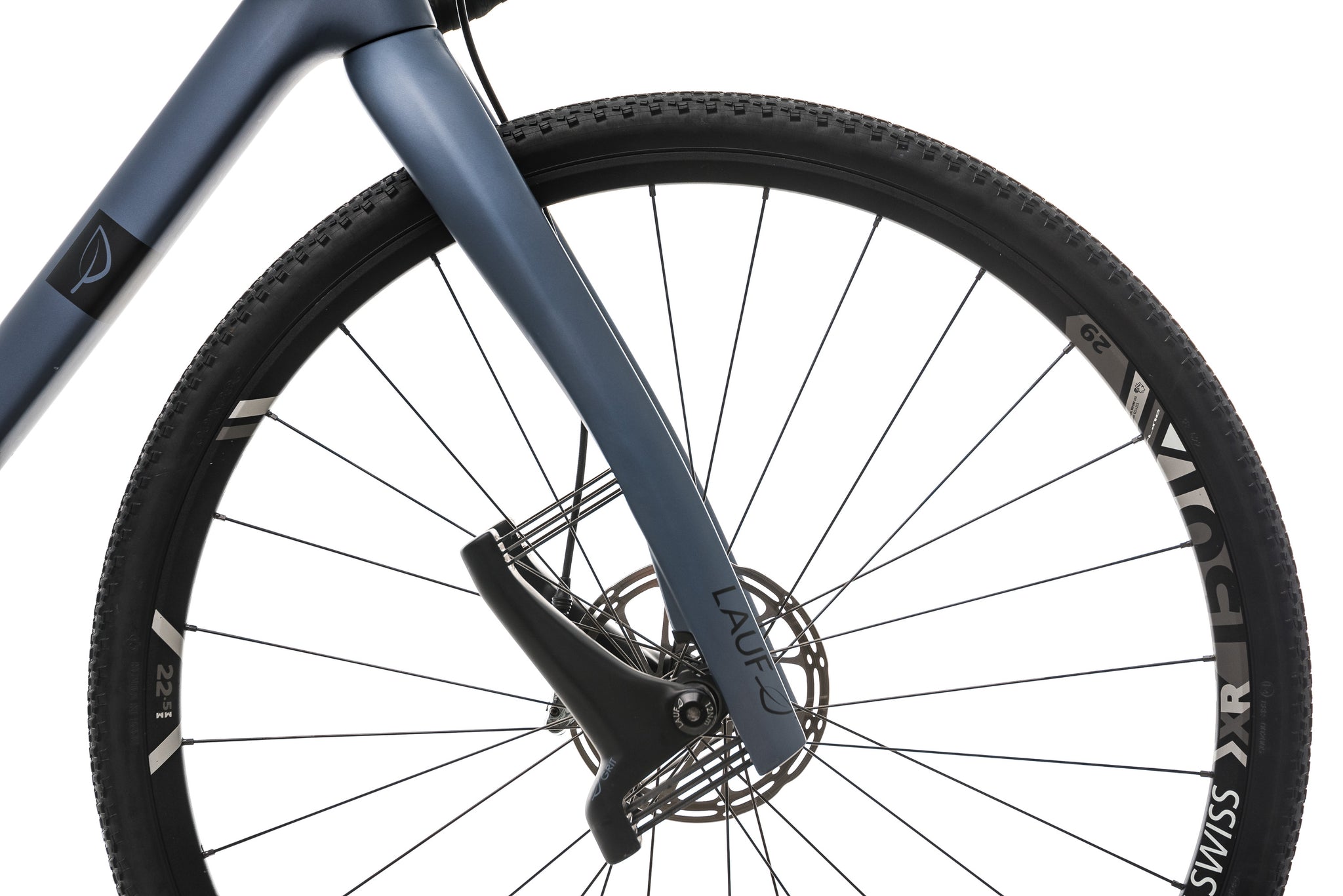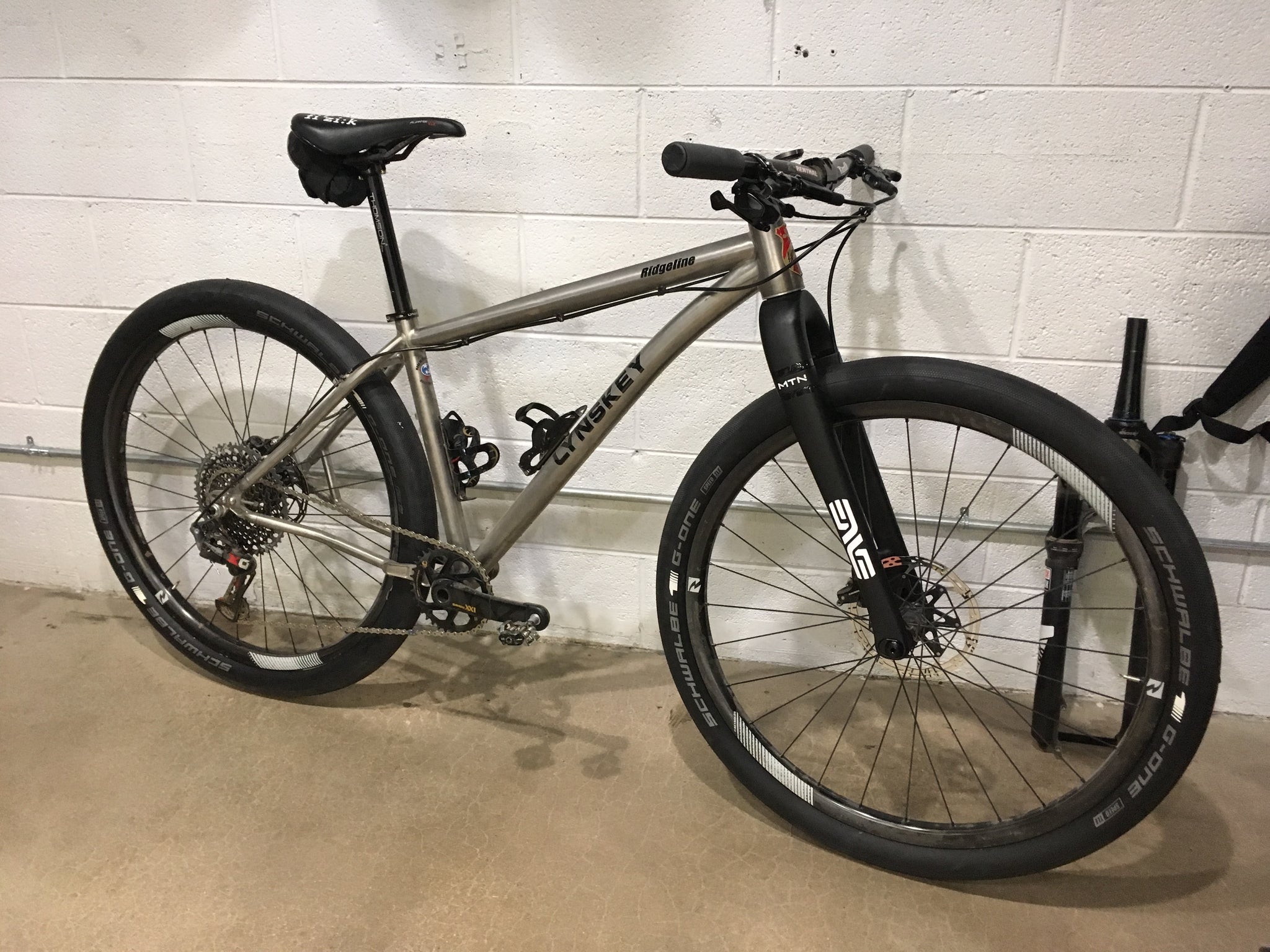Do you need a gravel bike to ride gravel roads? Of course not. Gravel riding is great because it blends the experiences of road and mountain biking. Your endurance road bike can handle many dirt routes with good tires and a sense of adventure.
But what about the original off-road machine? Long before the gravel trend, people were riding mountain bikes on dirt and gravel roads. And though gravel bikes look a lot like road bikes, most of the technology — such as tubeless tires, disc brakes, and clutch derailleurs — was adapted from mountain bikes.
[button]SHOP GRAVEL BIKES[/button]
So you want to explore mixed terrain, from gravel roads to light singletrack trails. Which type of bike do you need? A gravel bike or a cross-country mountain bike? Let's compare the pros and cons of each
Contents:
Gravel bike vs. mountain bike: Comparison
| Gravel bike | XC mountain bike | |
| Handlebars | Drop bars | Flat or riser bars |
| Typical weight | 17-22 pounds | 20-25 pounds |
| Typical gear range | 40-46t single chainring with 10-42t to 10-52t cassette, or conventional road bike gearing | 10-50t to 10-52t cassette with 30-36t single chainring |
| Suspension | Rarely any; 30-40mm suspension fork | 100-120mm suspension fork; 90-120mm rear suspension in some cases |
| Typical tire size | 36-45mm | 2.1-2.4" (53-61mm) |
Drop vs. flat handlebars
The most noticeable trait that separates gravel bikes from mountain bikes is the handlebar. Gravel bikes use curved drop handlebars, like road bikes, while mountain bikes use flat handlebars. Sure, flat-bar gravel bikes and drop-bar mountain bikes exist, but they are rare.

Gravel bikes are normally ridden at higher speeds on smoother roads and over longer distances. Drop handlebars provide more hand positions, allowing the rider to adjust their hands to improve comfort and reduce fatigue on long days in the saddle. The drops also provide a lower, more aerodynamic position and leverage for sprinting. Drop bars give gravel bikes versatility for riding at high speeds, as they are meant to transition easily between paved and gravel roads. Plus, these bars are also usually narrower than flat bars, making them better for riding shoulder-to-shoulder with other riders during group rides and races.
 Mountain bike flat bars are wider than drop bars and provide stability and leverage on rough and technical singletrack trails. Flat handlebars often give the rider a more upright position with their hands further apart. This can be more comfortable, but it makes you less aerodynamic for higher speeds on smooth, open roads. Flat bars are best for the slower speeds encountered on singletrack trails.
Mountain bike flat bars are wider than drop bars and provide stability and leverage on rough and technical singletrack trails. Flat handlebars often give the rider a more upright position with their hands further apart. This can be more comfortable, but it makes you less aerodynamic for higher speeds on smooth, open roads. Flat bars are best for the slower speeds encountered on singletrack trails.
Tire clearance
Gravel bikes can fit wider tires than road and cyclocross bikes, generally in the 38-45mm range. A few models are now capable of fitting up to 50mm tires. Wide tires with more tire volume improve comfort and traction.
The largest gravel tires are still narrower than most mountain bike tires. The majority of XC mountain bikes are designed to fit tires in the range of 2.1-2.4” wide (50mm gravel tires measure about 1.97”). Mountain bike tires are heavier slower rolling but offer the most comfort and traction.
Like the handlebar comparison, gravel bike tires have an advantage on faster, smoother terrain, while mountain bike tires can handle rougher roads and trails.
[newsletter]
Suspension
Suspension takes the edge off of the bumps and increases comfort and control. Most mountain bikes have at least a suspension fork, but the majority of gravel bikes are "rigid" to save weight and maximize pedaling efficiency.
 A few gravel bike models utilize suspension, but they are rare. Many riders who desire suspension for their gravel bike will need to purchase aftermarket suspension forks.
A few gravel bike models utilize suspension, but they are rare. Many riders who desire suspension for their gravel bike will need to purchase aftermarket suspension forks.
Notable examples of gravel-specific suspension forks are the Lauf Grit fork, RockShox Rudy, FOX AX fork, and MRP Baxter fork. These forks provide significantly less travel than mountain bike forks — 30-40mm.
 The Lauf Grit SL gravel suspension fork.
The Lauf Grit SL gravel suspension fork.
This small amount of travel can smooth out bumps and chatter on rough gravel roads while remaining efficient enough for smooth gravel and paved roads. But if you're used to the plush comfort of a mountain bike fork, you will find them to be pretty firm.
Read more: Do gravel bikes need suspension forks?
Gearing
As a broad generalization, gravel bikes will have “harder” gearing, again, to suit faster speeds. Mountain bikes will have relatively “easier” gearing for steep and technical off-road climbs. Both gravel and mountain bikes have limitations when it comes to gearing.
Take, for example, a gravel bike and a mountain bike each equipped with the latest SRAM 1x drivetrain. Gravel bikes with a XPLR eTap AXS gravel drivetrain might use a 42t chainring and a 10-44t cassette. Mountain bikes with an Eagle drivetrain might use a 32t chainring and a 10-50t cassette.
Both have pretty wide gear ranges. However, the hardest gear combinations provided by the drivetrains are very different: 42t-10t and 32t-10t, respectively. Because the gravel bike is able to fit a much larger (42t) chainring, you are less likely to “spin out” or run out of gears when pedaling at high speeds (above 30mph).
The easiest gear combinations are 42t-44t and 32t-50t. Because the mountain bike provides a substantially lower gear, it will be much easier to pedal up difficult climbs.
Of course you can customize your drivetrain to suit your needs, but most stock gravel bikes come geared for faster riding. They will generally have a larger 1x chainring or a 2x set-up.
Read more: 1x vs. 2x gravel drivetrains
Mountain bike gearing might be desirable for gravel riders who need an easier gear for hard climbing, riding while loaded with heavy bike-packing gear, or slow, technical gravel and singletrack trails.
Gravel bikes can be converted to use a mountain bike drivetrain (e.g., SRAM AXS allows for a “mullet” set-up using the 10-50t mountain cassette). But most mountain bikes don’t have enough clearance to fit the larger chainrings of gravel bike drivetrains and top-end speed will always be limited compared to gravel bikes.
[button]SHOP HARDTAIL MOUNTAIN BIKES[/button]
Geometry
Compared to road or cyclocross bikes, gravel bikes place riders in a more upright endurance position for stability, control, and comfort when riding off-road. Gravel bikes can be considered a middle ground between road bikes and mountain bikes. Mountain bike geometry is even more upright and won’t feel as quick-handling on pavement or smooth gravel, but it feels more stable and confidence-inspiring on extremely rough gravel and singletrack trails.
Ride characteristics
Comfort and fit
On gravel, tires offer the majority of riding comfort thanks to more air volume run at lower pressure, absorbing bumps and vibrations. Gravel tires in the 38-45mm range will be fine for typical gravel roads. If you’re riding extremely rough terrain or trails, you may benefit from the larger tires and additional suspension offered by mountain bikes.
Most gravel bikes are designed to provide a fairly comfortable riding position, but if you have severe flexibility limitations or other comfort issues that a gravel bike can’t accommodate, a mountain bike with a more upright position is a good option.
Confidence and capability
 If you’re not comfortable riding on dirt and gravel or you're regularly riding singletrack trails, mountain bikes are the better option. The flat handlebars, suspension, wider tires, and mountain bike geometry give riders maximum stability, traction, and control. That's great for pushing the limit or getting comfortable venturing away from the pavement.
If you’re not comfortable riding on dirt and gravel or you're regularly riding singletrack trails, mountain bikes are the better option. The flat handlebars, suspension, wider tires, and mountain bike geometry give riders maximum stability, traction, and control. That's great for pushing the limit or getting comfortable venturing away from the pavement.
But unless you start venturing onto tougher mountain bike trails, the speed and efficiency of a gravel bike wins out. Plus, you may be surprised by how much rough and technical terrain you can successfully ride on those skinny tires.
Speed and efficiency
By now it should be clear that a gravel bike has the upper hand on smooth surfaces, whether paved or gravel. Drop bars offer a more aerodynamic profile. Narrower tires have less rolling resistance. And the harder gearing is better for high speeds.
Fitness is a big factor, but it will always be easier to keep up with a fast gravel group ride while on a gravel bike. Mountain bikes will, of course, be faster than gravel bikes on true mountain bike terrain like technical singletrack trails.
Weight is also a consideration. Gravel bikes often weigh less than comparable mountain bikes.
Gravel vs. MTB: How to choose
What is your local terrain like? What type of roads or trails do you ride regularly? Let’s say you mostly ride from your house to explore dirt and gravel roads. You might have to ride several miles of paved roads through town before you get out to the good stuff. In this case, a gravel bike that balances efficiency on the pavement with fun on the gravel would be ideal.
If you dream about wandering onto poorly maintained Jeep roads or rocky and rooty singletrack, a cross-country mountain bike might be better. It will allow you to explore the worst terrain you will encounter.
Beyond your terrain, your experience and goals might influence your decision. Is your dream to finish the Unbound 200 gravel race or something similar? If you want to ride hard in a group of riders, race competitively, or just go fast and set new personal bests, then a more efficient race-focused gravel bike will be more desirable. On the other hand, if your friends might talk you into off-road races like the Epic Rides series or Leadville Trail 100, a mountain bike is the more versatile setup.
[button]SHOP GRAVEL BIKES[/button]
My experience
 Who has the better bike in this situation?
Who has the better bike in this situation?
I’ve been on plenty of rides where both gravel bikes and mountain bikes were present, and I've experimented with different gravel bikes and even a hardtail 29er mountain bike.
I successfully raced a gravel bike for several years, then in late 2018, I began fantasizing about doing rides that would explore more rugged trails and have one bike that could do everything. I switched to a hardtail 29er with a rigid carbon fork. The fork reduced weight and improved pedaling efficiency. The flat bars and large 2.35” tires made it confidence-inspiring on singletrack trails.

Over time, my goals shifted toward competition, and the 29er hardtail simply couldn’t keep up. Top speed was limited by aerodynamics and gearing. I found myself regularly spun out and getting dropped when speeds started entering the mid-20s.
I've returned to a faster and more efficient gravel bike because I want every advantage possible. Gravel riding is still evolving. And I'm always evolving as a rider. Whatever bike you're on, the most important thing is that it can put a smile on your face. The only gravel "rule" you should worry about is having fun.
Have you used a mountain bike for gravel riding or a gravel bike on mountain bike trails? What bike do you choose and why? Let us know in the comments!
























